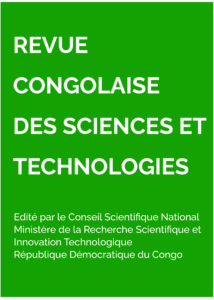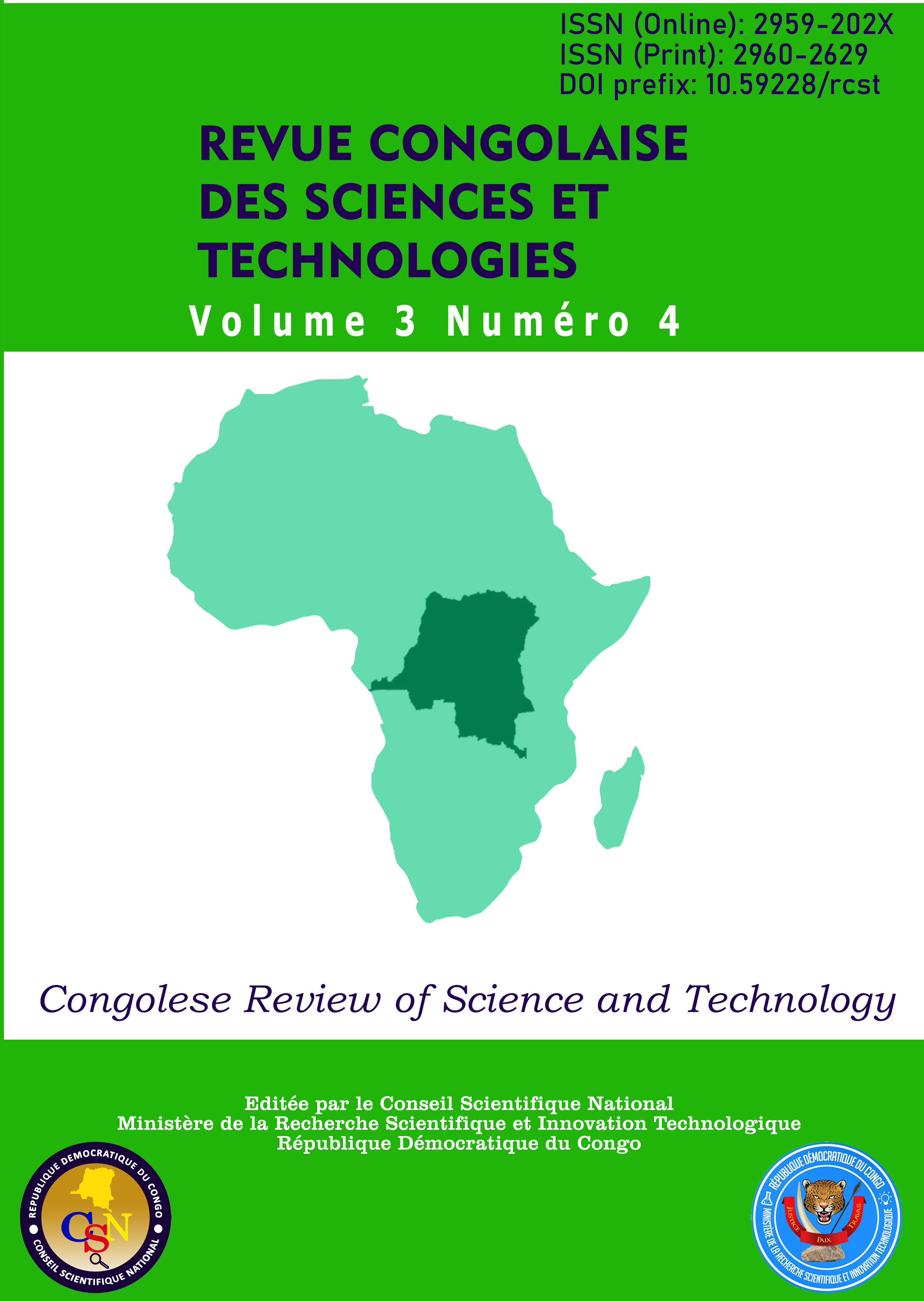Contribution to the fight against unsanitary conditions linked to plastic bottles in the city of Kisangani in the Democratic Republic of Congo. Study c arried out in the Tshopo commune
Main Article Content
Abstract
The town of Kisangani, in the Tshopo province in the Democratic Republic of Congo, is facing a major sanitation challenge due to the accumulation of plastic waste, particularly plastic bottles. Not only does this waste pollute the environment, it also poses a risk to public health and harms biodiversity. To combat this problem, a number of initiatives can be put in place. First and foremost, it's essential to raise public awareness of the dangers of plastic waste and the importance of recycling it. Educational campaigns can also be organized in schools and communities to encourage responsible behavior in terms of waste consumption and disposal. This study was carried out to determine the sources of insalubrity linked to plastic bottles in the city of Kisangani, to identify the consequences of insalubrity in the city of Kisangani and to develop methods, techniques and strategies to combat this type of insalubrity in the city of Kisangani. This is a cross-sectional qualitative descriptive study. The study population consisted of randomly selected residents of six of the city's communes. Interviews were used to collect data on the basis of a pre-established questionnaire. In addition, the data was supplemented by an analysis of documents from the roads and drainage department and the urban planning and housing department. The data collected showed that the causes of insalubrity linked to plastic bottles in the city of Kisangani are shared between the public services and the population. Insalubrity linked to plastic also presents a number of dangers for human health, the environment and biodiversity, including air and water pollution, soil defertilization, insect proliferation and certain pathogens facilitating the transmission of certain infectious diseases. Several solutions were proposed by the respondents, such as the use of SALONGO every Wednesday and Saturday, a forced sanitation program advocated by the public authorities, the installation of public garbage cans, the organization of a state-run waste collection and disposal system on every avenue; and some were founded to the public authorities, notably the valorization of plastic waste into products with energy value, the valorization of plastic waste into building materials to make the commune of Tshopo salubrious.
Article Details
Section

This work is licensed under a Creative Commons Attribution-NonCommercial-ShareAlike 4.0 International License.
References
Apolinaire, T. (2003). La gestion des déchets solides ménagers à Niamey au Niger : essai pour une stratégie de gestion durable [Thèse de Doctorat, Institut National des Sciences Appliquées de Lyon].
Bagalwa, M., Karume, K., Mushagalusha, N.G., Ndegeyi, K., Birali, M. M., Zirirane, N., Masheka, Z. & Bayongwa, C. (2013). Risques potentiels des déchets domestiques sur la santé des populations en milieu rural : cas d’Irhambi Katana (Sud-Kivu, République Démocratique du Congo). VertigO,13(2),2–13. Doi : 10.4000/vertigo.14085.
Compaoré, E & Nanéma, L.S. (2010). Compostage et qualité du compost de déchets urbains solides de la ville de Bobo-Dioulasso, Burkina Faso. Tropicultura, 28(4), 232–237.
De Bonville, J. (2006). L’analyse de contenu des médias. Bruxelles, De Boek.
Duval, C. (2004). Matières plastiques et environnement : recyclage, valorisation, biodégradabilité, écoconception. Paris, Dunod.
Ehrenstein, G.W., Riedel, G., Trawiel, P. (2004). Thermal Analysis of Plastics: Theory and Practice. München, Carl Hanser Verlag GmbH.
Elzafraney, M., Soroushian, P., Deru, M. (2005). Development of energy-efficient concrete buildings using recycled plastic aggregates. Journal of Architectural Engineering. 11(4),122–130.
Forget, G. & J. Lebel. (2002). An ecosystem approach to human health. International Journal of Occupational and Environmental Health, 7(1),3–36.
Hsu, B.M., Huang, C., Jiang, G.Y., Hsu, C.L. (1999). The prevalence of Giardia and Cryptosporidium in Taiwan water supplies. J. Toxicol. Environ. Health A, 57(3), 149–160.
https://medd.gouv.cd/fonds-dintervention-pour-lenvironnement/. Consulté le 20/11/2024 à 11h05.
Jambeck, J.R., Geyer, R., Wilcox, C., Siegler, T.R., Perryman, M., Andrady, A. et al. (2015). Plastic waste inputs from land into the ocean. Science, 347(2):768–71.
Katshekewa, R.B. (2017). Perception du risque lié à l'habitat insalubre en milieu urbain [Mémoire de DEA, Université de Lubumbashi]
Koné, B. (2008). Pollution lagunaire, risques sanitaires et environnementaux dans trois villages péri-urbains de la commune de Yopougon (Abidjan, Côte d’Ivoire) [Thèse unique de Doctorat, Université d’Abobo-Adjamé].
Luijsterburg, B & Goossens, H. (2014). Assessment of plastic packaging waste: Material origin, methods, properties. Resources, Conservation and Recycling, 85(1):88–97.
Marzouk, O.Y., Dheilly, R.M., Queneudec, M. (2007). Valorization of post-consumer waste plastic in cementitious concrete composites. Waste Management, 27(2):310–318.
Navab-Daneshmand, T., Friedrich, M.N.D., Gächter, M., Montealegre, M.C., Mlambo, L.S., Nhiwatiwa, T., Mosler, H-J., Julian, T.R. (2018). Escherichia coli Contamination across Multiple Environmental Compartments (Soil, Hands, Drinking Water, and Handwashing Water) in Urban Harare: Correlations and Risk Factors. American Journal of Tropical Medicine and Hygiene, 98(3),803–813. doi: 10.4269/ajtmh.17-0521.
Nkula, G.N., Kongolo, B.T., Kudiakubanza, A.K. (2023). Impact des déchets ménagers sur l’environnement et la santé dans la périphérie de Kinshasa, RDC. African Scientific Journal, 3(16), 1–26.
Possilétya, J.K-B., Kouamé, V.K., Doukouré, C.F., Yapi, D.A.C., Kouadio, A.S., Ballo, Z., Sanogo, T. A. (2019). Risques sanitaires liés aux déchets ménagers sur la population d’Anyama (Abidjan-Côte d’Ivoire). VertigO, 19(1), 24–36. https://doi.org/10.4000/vertigo.24417
Saikia, N. & De Brito, J. (2012). Use of plastic waste as aggregate in cement mortar and concrete preparation: A review. Construction and Building Materials, 34(4),385–401.
Schüle, S.A., Clowes, P., Kroidl, I., Kowuor, D.O., Nsojo, A. et al. (2014). Ascaris lumbricoides Infection and Its Relation to Environmental Factors in the Mbeya Region of Tanzania, a Cross-Sectional, Population-Based Study. PLoS One, 9(3):e92032. doi: 10.1371/journal.pone.0092032.
Shen, L., Worrell, E., Patel, M. (2010). Present and future development in plastics from biomass. Biofuels, Bioprod. Bioref. 4(1):25–40.

